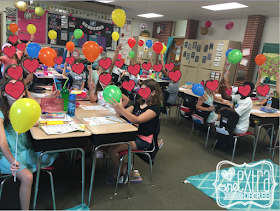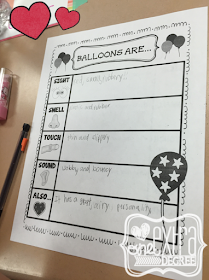I like to use "Many Luscious Lollipops" as a read aloud because it sets the stage for lollipops to become our common denominator, so to speak. We briefly read the book and discuss adjectives. My students are typically pretty with it when it comes to adjectives, but character traits are usually tricky business. Because we start out the year with characterization AND we begin writing narratives, I want them to understand that characters are multi-dimensional. They have complex inner-workings, and they also have appearances that deserve our attention as readers and writers. This book sets the stage for those discussions...and a sweet treat.
We begin by discussing why adjectives are so important in general, and why they are so important in stories before I distribute lollipops to my students. I like to use Dum-Dums because they are cheap, they have a ton of variety, and they are small so they don't require a lot of time to eat. (I literally spent $3.00 on 75 lollipops! I love how inexpensive this lesson is!)
Next, my students fill out a sensory language sheet describing lollipops using character traits, and we discuss the process...and precise language. I stress that precise language helps us EXPERIENCE texts as they are intended to be experienced.
Then, I pass another "lollipop" to my students--- a balloon on a stick. This is always a highlight of their day. (If you ever want to drive your students completely batty and build anticipation, just start sticking these balloons around your classroom during dismissal the day before you plan to launch the lesson. I guarantee you will have students excitedly asking what the balloons are for and hypothesizing all sorts of scenarios. I just let my students' imaginations run wild and build a little suspense, and it always seems to make the lesson that much "sweeter".
(As a side-note, another money-saving trick is to "recycle" the balloon sticks year after year! I have had mine for six years, and I used the same set of sticks with two classes this year. It took a little extra work to blow up the second set of balloons while my students were working during this lesson, but I was still able to walk about and conference with my students while simultaneously prepping for my next class. This is definitely doable if you are departmentalized with multiple classes. It just requires a little multitasking, but as you know, teachers are multitasking masters, right?!)
We spend a few minutes defining character traits and contrasting it with adjectives. I like to use Spongebob as our example. I have the students describe him using adjectives first. They will say things like "yellow", "porous", and "square". When I ask them to begin describing his personality, or character traits, they say things like, "obnoxious", "immature", and "friendly". Using a familiar character makes the concept more universally accessible for all students, and they think it's fun.
Once I establish that they understand what a character trait is, I have them write their names on their own "lollipops". Then I have them write five character traits that describe them.
The kids then pass the balloon around their tables, and they have to add one character trait that pertains to each friend without repeating any. I give them a character trait list to use as a reference.
Once the balloons make it all around the table, I have my students read the comments. First of all, it's great affirmation for my students. (I stress using this as a bucket filling time. No put-downs are allowed. We discuss that people and characters have positive and negative traits, but I stress that this is not a time to focus on the negatives because people's feelings are involved. We focus, instead, on building confidence and building community, which is why this is great to do at the beginning of the school-year!) Once they read the character traits, my students list the character traits that they believe do, in fact, pertain to them. They also list adjectives that describe their appearances and draw an accompanying picture. I love seeing what they come up with. :)
Eventually, we move on to group practice. I always do one example with them, so I project it onto our SMARTboard. We read the text, and we determine character traits that would pertain to the character, then my students have to support their answers with evidence from the text. Since this is a short text, it is really accessible and doesn't take up inordinate amounts of time, but it still gives enough information to allow for a variety of student responses, and in turn, it opens the door to great discussions as a class.
Then, I randomly count my kiddos off, put them into groups, and they practice doing the same activity in small groups with different short passages.
They fill out graphic organizers to record character traits in the "Inside" box and adjectives on the "Oustide" box for each character.
You know they they are taking it all very seriously when the clipboards come out! :)
On the other side, the students choose two character traits to elaborate upon, and they provide evidence from the text to support their answers. They also draw a picture of their characters.
In the past, I have projected each character on the SMARTboard while each group reads the texts and shares their character traits and evidence with their classmates. Then it's the perfect time for an exit ticket! I like to just have them write the difference between adjectives and character traits on a Post-It to keep it simple and effective. Easy-peasy!
If you're looking for a fun way to teach character traits, this is a sweet lesson to help the concept stick, but don't just take my word for it. This lesson is one of my best-sellers, and you can read comments from countless others who have successfully implemented this lesson with their students! Click on the image below to learn more or CLICK HERE!























Love the character trait ideas with lollipops and balloons! Such a smart idea to bring adjectives in BEFORE teaching about character traits! All I've got to say is LUNGS of STEEL! LOL! The balloon idea is perfect! Clever way to get engagement up. Totally saving this idea for when we're finally ready to tackle character traits. Thanks Amanda!
ReplyDeleteThank you so much for this post!! I have this product from you, and I've used it, but not like this. I love your activities! I LOVE how you've taught this lesson! I would not have thought of giving them lollipops. So cute!
ReplyDeleteThank you, again.
Jamie
I absolutely love this!!!! I (almost) wish that it wasn't the weekend so I can do it with my students now. Keep your great ideas coming because I am "eating" it up.
ReplyDeleteشركة تنظيف بالرياض
ReplyDeleteشركة تنظيف فلل بالرياض
شركة تنظيف شقق بالرياض
شركة تنظيف مجالس بالرياض
شركة تنظيف خزنات بالرياض
شركة مكافحة حشرات بالرياض
شركة تخزين اثاث بالرياض
شركة تسليك مجارى بالرياض
شركة رش مبيدات بالرياض
شركة نظافه بالرياض
شركة تنظيف منازل بالرياض